Dragon Ball Z: Level 1.1 Blu-ray Movie
HomeDragon Ball Z: Level 1.1 Blu-ray Movie 
FUNimation Entertainment | 1989-1990 | 410 min | Rated TV-PG | Nov 08, 2011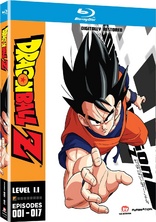
Movie rating
8.4 | / 10 |
Blu-ray rating
| Users | 4.3 | |
| Reviewer | 4.0 | |
| Overall | 4.1 |
Overview
Dragon Ball Z: Level 1.1 (1989-1990)
Raditz, Goku\'s brother has traveled to Earth to find out why Gokuu has not yet destroyed the planet as he was supposed to do. But while as a baby, Goku was dropped (down a huge cliff) and forgot his real mission. Kakarot, Goku\'s real name battles his brother Raditzs along with former enemy Piccolo and friend Kurilin. Meanwhile, Gohan; Goku\'s son reveals his hidden powers against Raditz and nearly kills Raditz. However Gokuu is killed in the end, but Raditz is eventually defeated by Piccolo. Before he dies, he tells them that two evil Saiyans even more powerful then he is, are on route to Earth. The remaining fighters, Kurilin, Yamcha, Tenshinhan, and Chatsu begin their training to battle the evil saiyans, while Piccolo takes off with Gohan to train him in using his new found power.
Starring: Daisuke Gōri, Mayumi Tanaka, Kenji Utsumi, Masako Nozawa, Toshio FurukawaNarrator: Jôji Yanami, Kyle Hebert, Doc Harris
Director: Daisuke Nishio, Yoshihiro Ueda, Mitsuo Hashimoto, Minoru Okazaki, Kazuhisa Takenouchi
| Anime | Uncertain |
| Foreign | Uncertain |
| Action | Uncertain |
| Fantasy | Uncertain |
| Comic book | Uncertain |
| Sci-Fi | Uncertain |
| Adventure | Uncertain |
| Martial arts | Uncertain |
| Comedy | Uncertain |
Specifications
Video
Video codec: MPEG-4 AVC
Video resolution: 1080p
Aspect ratio: 1.33:1
Original aspect ratio: 1.33:1
Audio
English: Dolby TrueHD 5.1 (48kHz, 16-bit)
English: Dolby TrueHD 2.0
Japanese: Dolby TrueHD Mono
All are 16-Bit
Subtitles
English
Discs
50GB Blu-ray Disc
Two-disc set (2 BDs)
Packaging
Slipcover in original pressing
Playback
Region A, B (locked)
Review
Rating summary
| Movie | 3.5 | |
| Video | 4.5 | |
| Audio | 4.5 | |
| Extras | 2.0 | |
| Overall | 4.0 |
Dragon Ball Z: Level 1.1 Blu-ray Movie Review
They're baaaack. Or they're till heeeeere.
Reviewed by Jeffrey Kauffman October 24, 2011When then candidate for President Ronald Reagan turned to Jimmy Carter during a debate, sighed a little and gave his trademark laugh, then stated, “There you go again,” the handwriting was on the wall for the Carter presidency. With Hallowe’en soon upon us, I frankly wouldn’t be surprised if scores of anime fans don Ronald Reagan masks and haunt the corporate headquarters of FUNimation, all of them echoing Reagan’s famous line. Certainly aninme fans are used by now to repackagings and revisions of everything from Evangelion to Ghost in the Shell, but haven't we just been getting through with the multi-volumed release of the Dragon Ball Z reboot, Dragon Ball Z Kai? And now Kai is being released in season sets, comprised of more episodes per volume than the first release? So what’s up with this “old, improved” Dragon Ball Z Level 1.1, and is it worth plunking down your hard earned cash? The answer to the first question is probably a bit easier than the second. Dragon Ball Z Level 1.1 is the first in what promises to be yet another huge set of volumes which will include all of the 291 episodes of the original series. Doing the math, and assuming that subsequent volumes will have more or less the same seventeen episodes that this first volume does, that works out to roughly sixteen more volumes to come after this one. If FUNimation follows suit as they have with Dragon Ball Z Kai, one would therefore expect that season sets of Dragon Ball Z will follow. So a not inconsiderable amount of money is going to exchange hands for rabid completists (and you know who you are). But here’s the catch, and one that will probably mean that most, if not all, Dragon Ball Z fans (and you know who you are) will indeed decide to plunk down their precious coinage to get either this set (or what I must assume in a few years will be the season sets): these new “levels” of Dragon Ball Z represent an enormous amount of time and money by FUNimation, a gargantuan effort that saw the anime specialists returning to the original Japanese film elements, transferring them frame by frame to high definition, and doing extensive restoration and color correction along the way. Add to that the fact that FUNimation has not skimped in the soundtrack department either, providing both the original FUNimation English track with Japanese music as well as the original English broadcast version (with that music), as well as the original Japanese track, and it seems clear that Dragon Ball Z aficionados are more likely than not going to be willing to spring for this set, no questions (or at least not very many questions) asked.
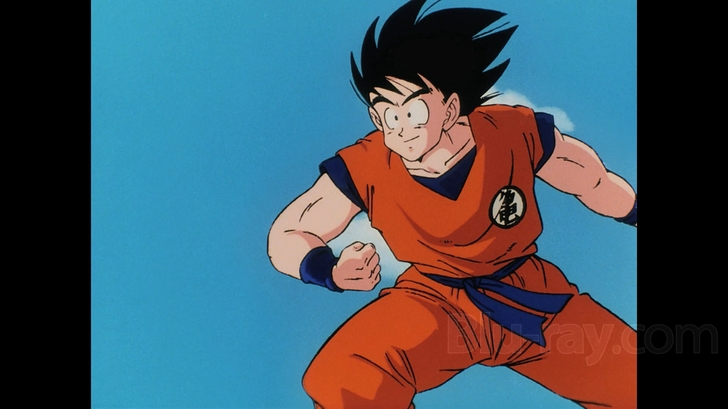
Because this is such an iconic series and this new Blu-ray release is so widely anticipated, this review will not spend much time on revisiting the plot or characters and will instead focus on the actual product and its pluses and minuses (if any). Let’s begin with FUNimation’s original press release announcing the high definition transfer of Dragon Ball Z:
Among the most prized in the FUNimation catalog, the studio has used the newest technology available to remaster in high-definition and digitally restore the 291 episode series. FUNimation worked with Dallas-based ANDTRANSFER for the digital film transfer. FUNimation previously worked with the post-production house to remaster the series for the season set releases on DVD. The transfer was performed by nationally-recognized colorist Steve Franko and supervised by FUNimation, which then finished the rest of the restoration process.
Today’s state-of-the-art systems offer tools that allow restoration teams to make a wide range of repairs and focus on more difficult tasks which, in the end, deliver a clean product that faithfully presents the original version and measures up to the high-quality standards of HDTV and Blu-ray.
Once again, the ‘Dragon Ball Z’ series was digitally transferred from the original Japanese 16mm film frame by frame at 1080p. Developments in restoration software gives mastering artists more to work with when they apply tools to even out film grain and remove fading, film cuts and other visual anomalies. As a result, the viewer will see brighter, clearer colors, less variance in quality between scenes, and a sharper image.
“Working with a very old and fragile source film presented a number of challenges for the restoration process,” said Gen Fukunaga, CEO and president at FUNimation Entertainment. “Our purpose was to restore the series as accurately as possible, to what it must have been like to see it when it was originally mastered, and preserve the charm of the animation. After all, it is of a particular time and place.” After debuting in 1989, ‘Dragon Ball Z’ has become an iconic anime series. The franchise has sold more than 25 million DVD and Blu-ray discs in its lifetime, becoming the best-selling anime series of all time.
It’s probably pointless to argue with the legion of Dragon Ball Z’s rabid fanbase about the intrinsic worth of the series. Those who grew up with Dragon Ball Z seem to love it in perhaps slightly (or frankly not so slightly) obsessive ways, and it seems kind of churlish to sour those childhood memories with comments denigrating the show’s tendency toward silliness and lots of filler material. But it really has to be stated that for all its charm (and there is an incredible amount of charm in Dragon Ball Z), the series is probably no more of a masterpiece than, say, The Flintstones. It’s a product of its time (much as Fred and Wilma were), and it’s a bit creaky, its flaws are more than evident, but it has a certain incalculable allure that is obviously very appealing to large swaths of people. That allure has generated an incredible amount of pre-release buzz among the Dragon Ball Z community, buzz centered on a whole host of obsessive-compulsive questions like whether the next episode previews (NEP in fan lingo) will be included, or which soundtrack and/or score will be utilized.
I freely admit to not being one of the more rabid Dragon Ball Z fans, and indeed the bulk of my interaction with the series prior to reviewing Dragon Ball Z Kai here for Blu-ray.com was in catching occasional episodes with my sons when they were broadcast, as both of my boys (especially my older boy) have loved the show since they first stumbled across it. With that caveat in mind and going by what FUNimation has told me as well as what I’ve researched, it seems evident that the Next Episode Previews are not included, though we do get the regular narrated wrap ups, which mention some salient plot points which will be covered in the next episode, as well as another narrated recap at the start of most episodes. In terms of the music, the answer is much clearer. The 5.1 mix includes the original Japanese score while the 2.0 mix includes the broadcast American score.
In terms of the story, this is the original, unfettered version of Dragon Ball Z, and so it’s a slower slog than the “all action, no filler” Dragon Ball Z Kai. The first seventeen episodes introduce us to our bevy of characters, including Gohan, Goku, Piccolo, Chiaotzu and countless others. Big green meanie Raditz fills up a lot of the opening story arc, providing Goku’s back story and filling the audience in on all things Saiyan. While there are an awful lot of slow spots in this extended original version, the saving grace here is the simply goofy humor, which elevates the show to unexpectedly enjoyable levels at virtually every turn. Dragon Ball Z was obviously a series whose creative staff didn’t take overly seriously, and that playful aspect is most likely what has endeared it now to several generations of diehard fans.
Dragon Ball Z: Level 1.1 Blu-ray Movie, Video Quality 

How you feel about grain is going to probably determine a lot about how you respond to this frame by frame restoration, presented via an AVC encode in 1080p and 1.33:1. As is mentioned in the accompanying featurette included on Disc 2 of this set, the restoration team had to toe a fine line between doing noise reduction and not interfering with the original film grain look. DNR phobes need not be worried in the slightest, because in fact some curmudgeons (yes, you know who you are) are probably going to swing to the opposite end of the spectrum and complain that this presentation is too grainy. I personally found it to be very filmic in appearance, more akin to the Fleischer classics of the 1930s and 1940s in a way, and for me, that is definitely not a bad thing. The best thing about this new restoration is the virtual lack of blemishes and damage (I did manage to catch a couple of niggling little items, but they're very minor). Also extremely impressive is the color correction, which literally casts a whole new light on several key characters. Line detail is extremely strong and distinct and colors are bold and very well saturated. If the overall series still sports a somewhat soft look, that's no doubt inherent in the original source elements as well as the animation style utilized (especially with regard to the painterly backgrounds).
Dragon Ball Z: Level 1.1 Blu-ray Movie, Audio Quality 
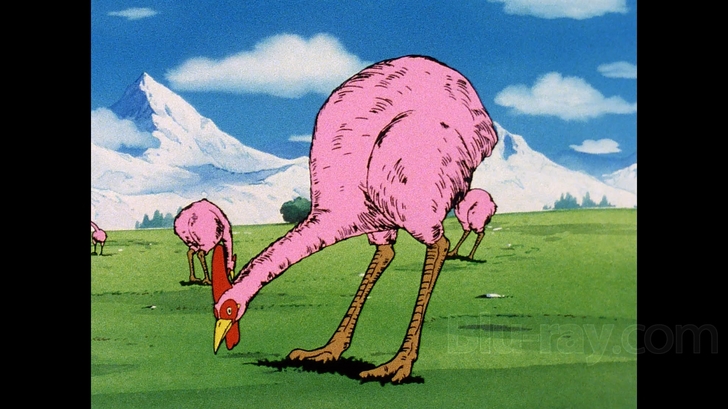
FUNimation has provided three lossless offerings on this Blu-ray, the English dub in Dolby TrueHD 5.1 with the original Japanese music, the original English language broadcast version (with broadcast version music) in Dolby TrueHD 2.0 and the original Japanese track (with Japanese music) in Dolby TrueHD mono. For the bulk of my watching, I opted for the 5.1 mix, as the synth heavy, proto-pop "stylings" of the broadcast version's music weren't as much to my personal liking as the 5.1's original Japanese music. Add to that some very smart and fun surround repurposing, without attendant fussiness or gimmickry, and the 5.1 track is the clear winner here, at least for those who want a fairly consistently immersive experience. Fidelity is top notch on this track, and the battle scenes are filled with slams, punches and crazy sound effects that ping pong around the surrounds with abandon. There's some great LFE in many (if not most) episodes, and the music is very well represented as well. Dynamic range is exceptional on this track, though truth be told, Dragon Ball Z tends to work at a fairly consistent hyperbolic level most of the time. The Japanese language track sounds noticeably muffled compared to the two English tracks, most likely due to age and the original recording environment and techniques.
Dragon Ball Z: Level 1.1 Blu-ray Movie, Special Features and Extras 
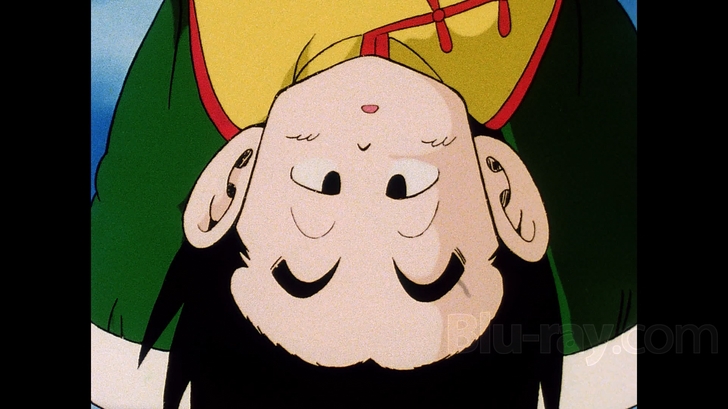
- Dragon Ball Z: Film to Blu-ray (HD; 7:48) is a sort of silly featurette done like a next episode preview, detailing the restoration efforts by FUNimation and the actual scanning and color timing facility.
- Textless Opening Song (HD; 1:52)
- Textless Closing Song (HD; 1:39)
- Marathon Feature allows you to view the episodes sequentially without intervening credits sequences.
Dragon Ball Z: Level 1.1 Blu-ray Movie, Overall Score and Recommendation 
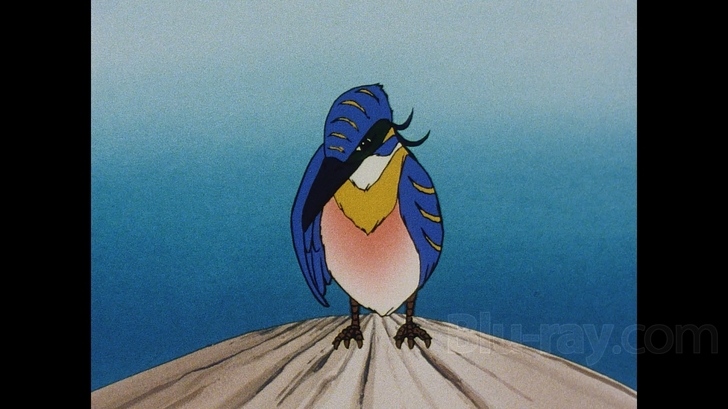
So the question still remains: is this latest (actually oldest) Dragon Ball Z worth it? And the answer firmly depends on how much you like the original version of the series. If you love it, this restoration is beautifully detailed and offers some nice choices in the soundtrack options. While supplements are meager (at least on this first outing), the increased clarity and saturation of this presentation, as well as its clean-up and color correction, argue for a purchase. If on the other hand you really couldn't care less about this version versus Kai, the allure is probably somewhat minimal. Though Kai is inarguably the faster mover iteration of the Dragon Ball Z franchise, it also leaves out quite a bit of material, and so for those who grew up with this original version and still love it, the handwriting, as in Reagan days of yore, is on the wall. Recommended.
Other editions
Dragon Ball Z: Other Seasons

Dragon Ball Z: Level 1.2
1990

Dragon Ball Z: Season 1
1989-1990

Dragon Ball Z: Season 1
1989-1990

Dragon Ball Z: Season 1
1989-1990

Dragon Ball Z: Season 2
1990-1991

Dragon Ball Z: Season 2
1990-1991

Dragon Ball Z: Season 2
1990-1991

Dragon Ball Z: Level 2.2
1990

Dragon Ball Z: Level 2.1
1990

Dragon Ball Z: Season 3
1991

Dragon Ball Z: Season 3
1991

Dragon Ball Z: Season 3
1991

Dragon Ball Z: Season 4
1991-1992

Dragon Ball Z: Season 4
1991-1992

Dragon Ball Z: Season 4
1991-1992

Dragon Ball Z: Season 5
1992

Dragon Ball Z: Season 5
1992

Dragon Ball Z: Season 5
1992

Dragon Ball Z: Season 6
1992-1993

Dragon Ball Z: Season 6
1992-1993

Dragon Ball Z: Season 6
1992-1993

Dragon Ball Z: Season 7
1993-1994

Dragon Ball Z: Season 7
1993-1994

Dragon Ball Z: Season 7
1993-1994

Dragon Ball Z: Season 8
1994-1995

Dragon Ball Z: Season 8
1994-1995

Dragon Ball Z: Season 8
1994-1995

Dragon Ball Z: Season 9
1995-1996

Dragon Ball Z: Season 9
1995-1996

Dragon Ball Z: Season 9
1995-1996
Similar titles
Similar titles you might also like

Dragon Ball GT
1996-1997

Dragon Ball Z: Resurrection 'F'
2015

Dragon Ball Z: Battle of Gods
Extended Edition
2013

Dragon Ball
1986-1989

Dragon Ball Z Kai: Season 1
2009

Dragon Ball Z: Bardock - The Father of Goku
1990

Dragon Ball Z The Movie 3: The Tree of Might
1990

Dragon Ball Z The Movie 8: Broly - The Legendary Super Saiyan
1993

Dragon Ball Super: Complete Series
Limited Edition
2015-2018

Dragon Ball Z The Movie 9: Bojack Unbound
1993

Dragon Ball Z The Movie 13: Wrath of the Dragon
1995

Dragon Ball Z The Movie 5: Cooler's Revenge
1991

Dragon Ball Z The Movie 1: Dead Zone
1989

Dragon Ball Z: The History of Trunks
1993

Dragon Ball Z The Movie 10: Broly - Second Coming
1994

Dragon Ball Z The Movie 7: Super Android 13
1992

Dragon Ball Z The Movie 2: The World's Strongest
1990

Naruto: The Complete Series
Limited Edition
2002-2007

Dragon Ball Z The Movie 4: Lord Slug
1991

Fairy Tail: Collection 1
2009-2010